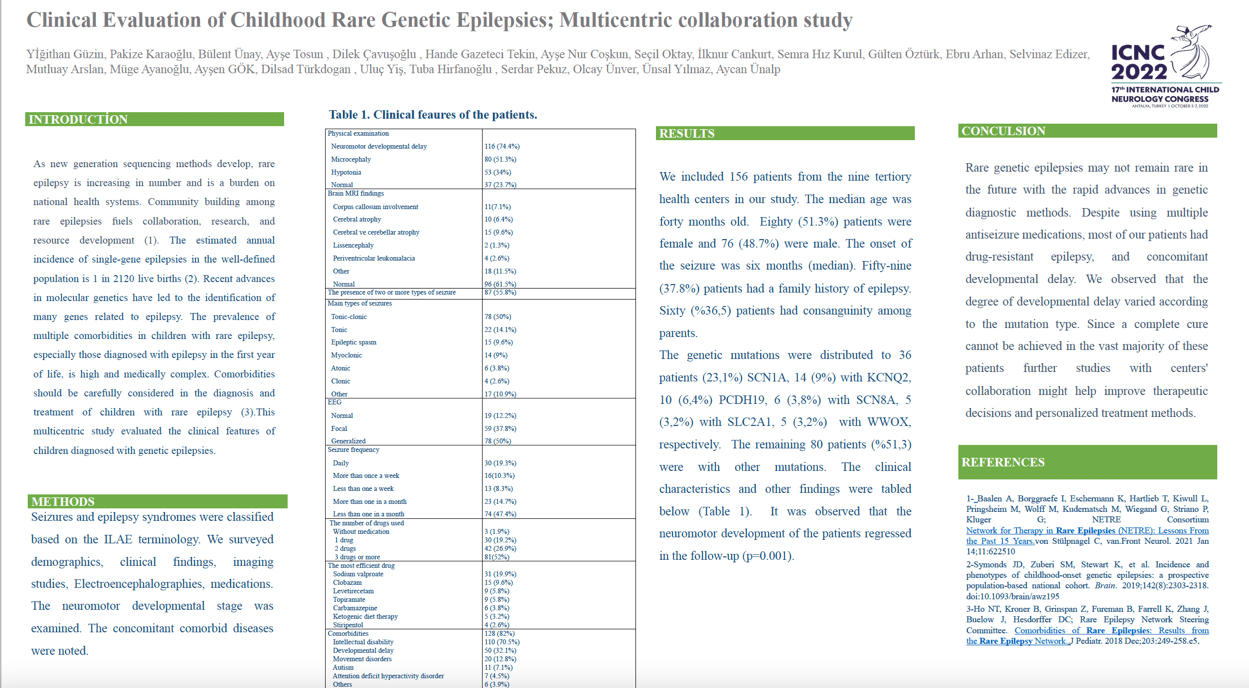Clinical Evaluation of Childhood Rare Genetic Epilepsies; Multicentric collaboration study
Yİğithan Güzin, Pakize Karaoğlu, Bülent Ünay, Ayşe Tosun , Dilek Çavuşoğlu , Hande Gazeteci Tekin, Ayşe Nur Coşkun, Seçil Oktay, İlknur Cankurt, Semra Hız Kurul, Gülten Öztürk, Ebru Arhan, Selvinaz Edizer, Mutluay Arslan, Müge Ayanoğlu, Ayşen GÖK, Dilsad Türkdogan , Uluç Yiş, Tuba Hirfanoğlu , Serdar Pekuz, Olcay Ünver, Ünsal Yılmaz, Aycan Ünalp
Introduction Recent advances in molecular genetics have led to the identification of many genes related to epilepsy. Rare genetic epilepsies are a heterogeneous group of diseases in which genotype/ phenotype correlation remains poorly understood. This multicentric study evaluated the clinical features of children diagnosed with genetic epilepsies. Methods This is a descriptive retrospective study of patients diagnosed with genetic epileptic encephalopathy. Patient demographics, brain MRI findings, EEGs, genetic testing, antiseizure medications, and clinical outcome were noted. Results We included 156 patients from nine pediatric neurology clinics of tertiary care in our country. The median age of the patients was 40 months. The age of the patients at the seizure onset was six months (median). We evaluated 36 (23.1%) patients with SCN1A, 14 (9%) with KCNQ2, 10 (6.4%) with PCDH19, 6 (3.8%) with SCN8A, 5 (3.2%) with SLC2A1, 5 (3.2%) with WWOX mutations. The remaining 80 patients had other rare genetic mutations. The clinical features of our patients are shown in Table 1. Most of the patients (%74.4) had cognitive and/or motor developmental delay, which became significantly more pronounced during the follow-up period. Conclusion Despite using multiple antiseizure medications, most of our patients had drug-resistant epilepsy and concomitant developmental delay. We observed that the degree of developmental delay varied according to the mutation type. Rare genetic epilepsies may not remain rare in the future with the rapid advances in genetic diagnostic methods. Further studies with centers' collaboration might help improve therapeutic decisions and personalized treatment methods.
Keywords: epilepsy, rare genetic mutations
Yİğithan Güzin
HEALTH SCIENCES UNIVERSITY İZMİR TEPECİK EDUCATION AND RESEARCH HOSPITAL
Turkey
Pakize Karaoğlu
Turkey
Bülent Ünay
University of Health Sciences, Gulhane Faculty of Medicine
Turkey
Ayşe Tosun
Aydın Adnan Menderes University
Turkey
Dilek Çavuşoğlu
Afyonkarahisar Health Sciences University Hospital
Turkey
Hande Gazeteci Tekin
BAKIRÇAY UNİVERSİTY ÇİĞLİ REGİONAL EDUCATİON HOSPİTAL
Turkey
Ayşe Nur Coşkun
Organization: University of Health Sciences, Gulhane Faculty of Medicine
Turkey
Seçil Oktay
Aydın Adnan Menderes University
Turkey
İlknur Cankurt
Gazi University School of Medicine
Turkey
Semra Hız Kurul
Dokuz Eylül University Faculty of Medicine
Turkey
Gülten Öztürk
Marmara University Pendik Training and Research Hospital
Turkey
Introduction Recent advances in molecular genetics have led to the identification of many genes related to epilepsy. Rare genetic epilepsies are a heterogeneous group of diseases in which genotype/ phenotype correlation remains poorly understood. This multicentric study evaluated the clinical features of children diagnosed with genetic epilepsies. Methods This is a descriptive retrospective study of patients diagnosed with genetic epileptic encephalopathy. Patient demographics, brain MRI findings, EEGs, genetic testing, antiseizure medications, and clinical outcome were noted. Results We included 156 patients from nine pediatric neurology clinics of tertiary care in our country. The median age of the patients was 40 months. The age of the patients at the seizure onset was six months (median). We evaluated 36 (23.1%) patients with SCN1A, 14 (9%) with KCNQ2, 10 (6.4%) with PCDH19, 6 (3.8%) with SCN8A, 5 (3.2%) with SLC2A1, 5 (3.2%) with WWOX mutations. The remaining 80 patients had other rare genetic mutations. The clinical features of our patients are shown in Table 1. Most of the patients (%74.4) had cognitive and/or motor developmental delay, which became significantly more pronounced during the follow-up period. Conclusion Despite using multiple antiseizure medications, most of our patients had drug-resistant epilepsy and concomitant developmental delay. We observed that the degree of developmental delay varied according to the mutation type. Rare genetic epilepsies may not remain rare in the future with the rapid advances in genetic diagnostic methods. Further studies with centers' collaboration might help improve therapeutic decisions and personalized treatment methods.
Keywords: epilepsy, rare genetic mutations
Yİğithan Güzin
HEALTH SCIENCES UNIVERSITY İZMİR TEPECİK EDUCATION AND RESEARCH HOSPITAL
Turkey
Pakize Karaoğlu
Turkey
Bülent Ünay
University of Health Sciences, Gulhane Faculty of Medicine
Turkey
Ayşe Tosun
Aydın Adnan Menderes University
Turkey
Dilek Çavuşoğlu
Afyonkarahisar Health Sciences University Hospital
Turkey
Hande Gazeteci Tekin
BAKIRÇAY UNİVERSİTY ÇİĞLİ REGİONAL EDUCATİON HOSPİTAL
Turkey
Ayşe Nur Coşkun
Organization: University of Health Sciences, Gulhane Faculty of Medicine
Turkey
Seçil Oktay
Aydın Adnan Menderes University
Turkey
İlknur Cankurt
Gazi University School of Medicine
Turkey
Semra Hız Kurul
Dokuz Eylül University Faculty of Medicine
Turkey
Gülten Öztürk
Marmara University Pendik Training and Research Hospital
Turkey

Yİğithan Güzin
HEALTH SCIENCES UNIVERSITY İZMİR TEPECİK EDUCATION AND RESEARCH HOSPITAL Turkey
HEALTH SCIENCES UNIVERSITY İZMİR TEPECİK EDUCATION AND RESEARCH HOSPITAL Turkey